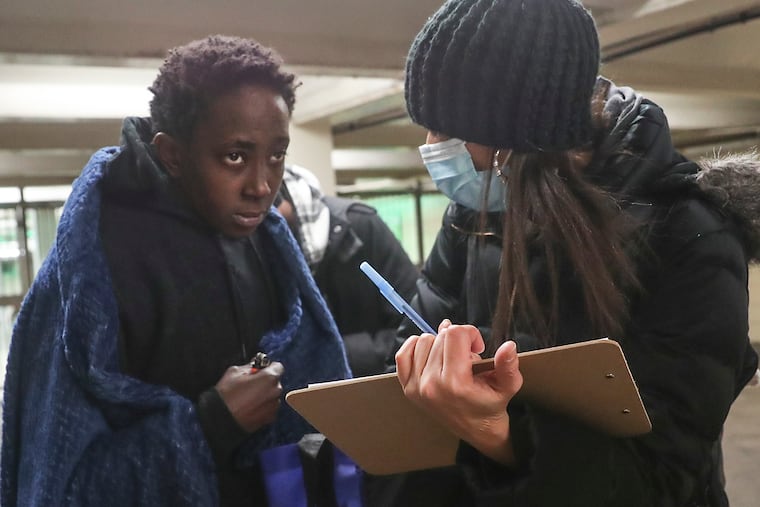Philly’s annual census of youths experiencing homelessness attracts counters who care
Two strangers shook hands, then hit the streets to help create a census to be used to better serve those living unhoused.

More than 100 volunteers gathered beneath huge panes of stained glass at Broad Street Ministry last Thursday on a mission to count the number of young adults experiencing homelessness on Philadelphia streets.
Aisha Childs, 48, a social services worker from Germantown, was assigned a portion of Center City with Ezekiel, 20, of West Philadelphia, a beauty-school student who knows personally what it’s like to live unhoused. Ezekiel’s last name is being withheld for personal safety concerns.
The two strangers shook hands, then hit the streets to help create a census to be used to better serve those living homeless. It was Ezekiel’s first youth count and Childs’ 10th.
“This is a reward for me,” said Childs, whose job is to assist women, children, and families at Public Health Management Corp. “I’m always looking to help someone in need.”
Point in Time
Last week volunteers throughout the United States fanned out to count people living homeless for the so-called Point in Time (PIT) Count, a requirement of the U.S. Department of Housing and Urban Development. It’s run in Philadelphia by the Office of Homeless Services.
On Thursday, the separate Youth PIT Count for young adults ages 18 to 24 (not federally required) was conducted in Philadelphia, also under OHS, with direction from Valley Youth House.
The numbers won’t be available until summer.
The city says homelessness in Philadelphia has been declining. In 2018, the number of all those living in shelters was 4,705, while the unsheltered population was 1,083. Among young adults, 1,822 were sheltered and 96 were unsheltered.
By last year, city figures show, the number of all sheltered individuals was 3,701; those living unsheltered totaled 788. The tallies among young adults: 1,077 sheltered, 73 unsheltered.
But many experts dispute the findings, with some estimating the population of those living on Philadelphia streets is closer to 1,200.
“The number of unsheltered is a vast undercount with this very imperfect PIT measure,” said Eric Tars, legal director of the National Homelessness Law Center.
For example, Tars said, volunteer counters are told that, for their safety, they should avoid parks, abandoned buildings, and alleys.
“But these are the places where the homeless most likely are,” Tars said.
An OHS spokesperson acknowledged that the PIT Count serves only as a “snapshot ... not a full picture of homelessness.”
Young adults are counted separately because they tend not to sleep outdoors at night, said Sister Mary Scullion, cofounder and executive director of Project HOME, the nationally renowned Philadelphia anti-homelessness nonprofit.
“Homeless youth are almost invisible,” she said. They most likely bunk doubled-up at friends’ houses, she added.
That describes Ezekiel’s situation.
“I was kicked out of my parents’ house for being gay,” Ezekiel said while walking with Childs north on Broad Street. “I’m transgender and nonbinary.” Ezekiel couch-surfed for a year after having spent a short amount of time on the street.
“Being homeless, you feel exhausted, like you’re never getting back on your feet,” Ezekiel said. “People you thought cared about you do not. It’s a heavy load.”
But with the help of friends and Valley Youth House, Ezekiel became a student at a beauty school, and now lives in an apartment.
Ezekiel thinks of doing the youth count as a way of giving back.
“Being homeless caused me to open my heart,” Ezekiel said. “I don’t want people to struggle the way I have.”
Walking through Center City, Ezekiel and Childs descended into the Broad Street Line station at 15th and Locust Street.
Six people appear to be living homeless in a wide, unused corridor under harsh fluorescent light.
Childs took charge.
Speaking softly, Childs conferred privately with a young woman named Kiki wrapped in a blue blanket. Childs asked survey questions supplied by the city but also used this brief moment of contact to comfort the skittish woman, then offered her a $5 gift certificate to Wawa.
Childs and Ezekiel tried speaking with another woman, with no success. “Her brain’s a little scrambled,” Childs said. “She said something about being tired of harassment by homeless men.”
As nearby trains roared, the two moved on to J.R., a young man who said he needed to get high before speaking. Afterward, he was edgy and taciturn, saying only, “I stay down here away from other people, for my health.”
With no one else willing to talk, Childs and Ezekiel climbed the stairs back onto South Broad Street.
‘Absolutely gentrified’
The pair walked for three hours around City Hall and LOVE Park, then into Suburban Station. They didn’t encounter any youths experiencing homelessness.
“This part of the city is absolutely gentrified,” Childs complained. “New construction pushes out the needy masses. It’s a little too ritzy down here.”
Childs confessed that, after 15 years at her job, she tells herself each new count is her last.
“But for some reason, I keep at it,” she said. “For every 50 people I serve, five to 10 come back to me after finding jobs and housing and tell me, ‘If it wasn’t for you, Miss Aisha. ...’
“I live for those thank-yous, for those lives changed.”
As darkness fell, she and Ezekiel headed back to Broad Street Ministry.
“I feel sad,” Childs said. “We didn’t come across the youth I know are out here.
“I wish we could have found more people to talk to. More people to count. More to help.”